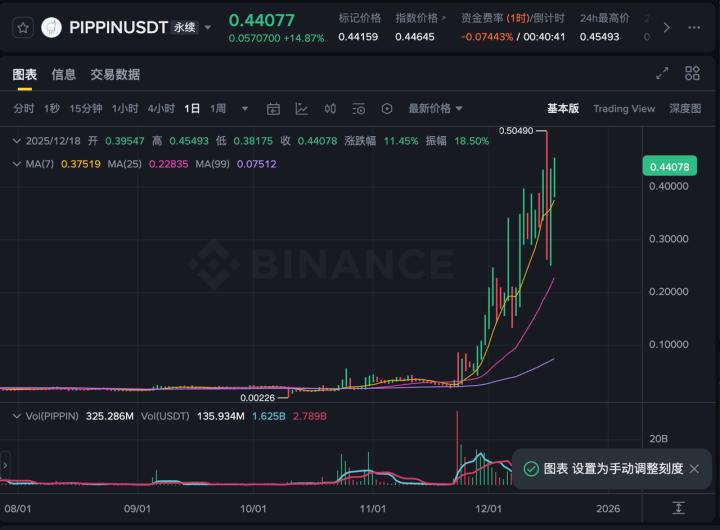Author: Pzai, Foresight News
As a company with a core strategy of holding BTC reserves, MicroStrategy (MSTR) has been a darling of US stock investors in recent years due to its steadfast support for BTC and the bullish crypto market environment.
However, since reaching a historic high of $589 on November 21, MSTR's share price has fallen by more than 44% to $300, with its market capitalization declining by 34% in the past two weeks alone. As a crypto-focused stock that stands out in the US equity market, the subtle changes in the market environment have also led to violent fluctuations in its share price. Ultimately, can the "Crypto Federal Reserve" narrative maintain its former glory?

Retreat from the Peak
Due to its business model, MicroStrategy's share price is highly correlated with the price of BTC. In December 2024, the BTC price fell by around 10% from its peak of $108,000 to around $97,000. This correction directly impacted the value of MicroStrategy's balance sheet, in turn weighing on its share price performance. MicroStrategy's share price has long traded at a premium to the value of its BTC holdings. In November 2024, this premium reached 3.5x, but by early 2025 it had contracted to 1.6x. The contraction of the premium suggests that investors' confidence in its "leveraged BTC investment" narrative is waning.

Correlation between MSTR stock price and BTC movement (Binance BTCUSD pair as the benchmark)
As of December 2024, MicroStrategy holds approximately 446,000 BTC, worth around $43 billion, making it the world's largest corporate BTC holder. This massive holding has given it a significant presence in the crypto market, and it was included in the Nasdaq index that month, becoming one of the few crypto-related stocks in the index.
However, apart from MSTR, global corporations still maintain a relatively cautious attitude towards BTC as an emerging asset, despite the potential returns and diversification benefits attracting the attention of some companies. The high volatility, regulatory uncertainty, and compatibility issues with traditional corporate financial strategies mean that most companies choose to wait and see or adopt a limited approach. For example, Microsoft shareholders rejected a BTC investment proposal in December 2024, with one of the main reasons being the incompatibility of BTC's high volatility with the company's need for stable investments. In a report to clients, Markus Thielen, founder of 10x Research, stated: "As MicroStrategy's stock price has fallen 44% from its peak, and other companies are adopting BTC as a reserve asset strategy on a smaller scale, the bullish narrative around traditional companies entering the space appears to be losing momentum."
Pressure on the Leverage Strategy
MicroStrategy has been financing its ongoing BTC purchases through the issuance of stocks and convertible bonds. This strategy was seen as a "flywheel for converting fiat to BTC" during the BTC bull market, attracting a large number of investors. The company's founder and CEO, Michael Saylor, has also publicly stated on multiple occasions that BTC is "digital gold" and the best tool to hedge against inflation. He has also been actively lobbying US companies and the government to embrace BTC.

However, since MicroStrategy's business model is highly dependent on the BTC price, any fluctuations in the BTC price will have a significant impact on its share price. After BTC reached a new all-time high, some investors chose to take profits, putting pressure on MicroStrategy's share price. On the policy front, the related assets have also faced some resistance. The Federal Reserve released hawkish signals at its December 2024 policy meeting, hinting at the possibility of further rate hikes to curb inflation. This policy shift dampened the appeal of the related assets, and MicroStrategy, as a leveraged BTC investment tool, was particularly affected.
MicroStrategy's leveraged strategy amplified its gains during the upswing, but also increased its risks during the downswing. Market concerns about its debt burden and refinancing ability have intensified, especially as the company may face greater financial pressure if BTC prices fall. Against the backdrop of a BTC price correction and weakening market sentiment, MicroStrategy's narrative has indeed faced challenges in the short term. Investors' concerns about its high premium and leverage risk have intensified, leading to a significant decline in its share price.
Outlook
We can see that MicroStrategy's share price performance will continue to be highly dependent on the BTC price. Its status as the "Crypto Federal Reserve" has been challenged in the short term due to the BTC price correction and changes in market sentiment, but its long-term potential still depends on the price trend of BTC and the company's capital operations. If BTC prices return to an upward trajectory, MicroStrategy's narrative may regain support. Especially if BTC is widely expected to be accepted as a store of value during the Trump administration, its strategy of continued BTC accumulation may continue to attract investors in the long run.
As investors' valuation of MicroStrategy becomes more rational, the deleveraging of its share price may bring it closer to the value of its BTC holdings, rather than maintaining a high premium. This rationalization process may lead to further adjustments in the share price, but it also provides better entry opportunities for long-term investors.
Moreover, the new accounting rules that will take effect in 2025 will allow MicroStrategy to report the fair value of its BTC holdings, which could significantly boost its net income and attract more institutional investors, potentially even leading to its inclusion in the S&P 500 index (although this is less likely). Although MicroStrategy's share price performance may continue to face pressure in the short term, its position as the largest corporate BTC holder still holds strategic significance in the market.
As of the time of writing, MSTR's share price is $300.01. As the BTC market gradually warms up, market sentiment is also expected to be reflected in its price. If the BTC market returns to an upward trend, MicroStrategy may once again become a focus of investor attention.







